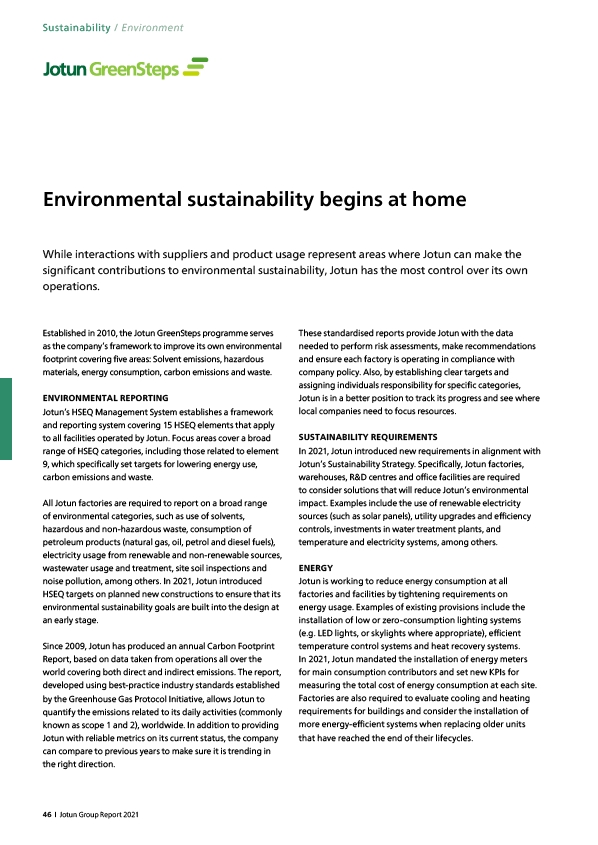
46 I Jotun Group Report 2021 Sustainability / Environment
Environmental sustainability begins at home
While interactions with suppliers and product usage represent areas where Jotun can make the
significant contributions to environmental sustainability, Jotun has the most control over its own
operations.
Established in 2010, the Jotun GreenSteps programme serves
as the company’s framework to improve its own environmental
footprint covering five areas: Solvent emissions, hazardous
materials, energy consumption, carbon emissions and waste.
ENVIRONMENTAL REPORTING
Jotun’s HSEQ Management System establishes a framework
and reporting system covering 15 HSEQ elements that apply
to all facilities operated by Jotun. Focus areas cover a broad
range of HSEQ categories, including those related to element
9, which specifically set targets for lowering energy use,
carbon emissions and waste.
All Jotun factories are required to report on a broad range
of environmental categories, such as use of solvents,
hazardous and non-hazardous waste, consumption of
petroleum products (natural gas, oil, petrol and diesel fuels),
electricity usage from renewable and non-renewable sources,
wastewater usage and treatment, site soil inspections and
noise pollution, among others. In 2021, Jotun introduced
HSEQ targets on planned new constructions to ensure that its
environmental sustainability goals are built into the design at
an early stage.
Since 2009, Jotun has produced an annual Carbon Footprint
Report, based on data taken from operations all over the
world covering both direct and indirect emissions. The report,
developed using best-practice industry standards established
by the Greenhouse Gas Protocol Initiative, allows Jotun to
quantify the emissions related to its daily activities (commonly
known as scope 1 and 2), worldwide. In addition to providing
Jotun with reliable metrics on its current status, the company
can compare to previous years to make sure it is trending in
the right direction.
These standardised reports provide Jotun with the data
needed to perform risk assessments, make recommendations
and ensure each factory is operating in compliance with
company policy. Also, by establishing clear targets and
assigning individuals responsibility for specific categories,
Jotun is in a better position to track its progress and see where
local companies need to focus resources.
SUSTAINABILITY REQUIREMENTS
In 2021, Jotun introduced new requirements in alignment with
Jotun’s Sustainability Strategy. Specifically, Jotun factories,
warehouses, R&D centres and office facilities are required
to consider solutions that will reduce Jotun’s environmental
impact. Examples include the use of renewable electricity
sources (such as solar panels), utility upgrades and efficiency
controls, investments in water treatment plants, and
temperature and electricity systems, among others.
ENERGY
Jotun is working to reduce energy consumption at all
factories and facilities by tightening requirements on
energy usage. Examples of existing provisions include the
installation of low or zero-consumption lighting systems
(e.g. LED lights, or skylights where appropriate), efficient
temperature control systems and heat recovery systems.
In 2021, Jotun mandated the installation of energy meters
for main consumption contributors and set new KPIs for
measuring the total cost of energy consumption at each site.
Factories are also required to evaluate cooling and heating
requirements for buildings and consider the installation of
more energy-efficient systems when replacing older units
that have reached the end of their lifecycles.